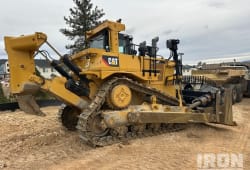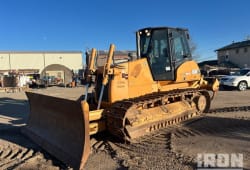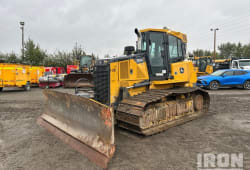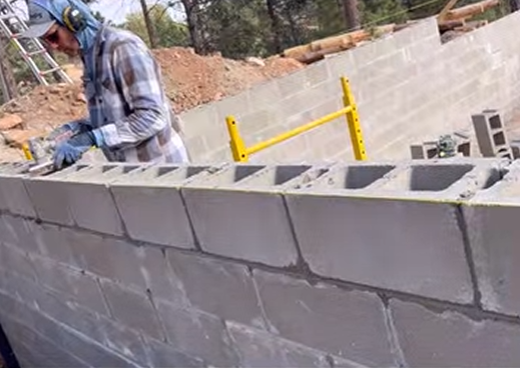Learning How Much Does a Bulldozer Weigh
7 Min read
)
March 9, 2022
Bulldozers are powerful machines that come in all different sizes for demolition and earthmoving purposes.
You can buy small bulldozers, medium bulldozers, or large dozers. On the heavier end of these three categories, larger models weigh upwards of 180 tons (or 360,000 pounds). Small dozers are available in as little as 8 tons (or 16,000 pounds). There is certain a reason this machinery is part of the "heavy equipment" category -- even the smallest weight of bulldozer options is in the tons.
Take A Look! Browse our Boom & Bucket inventory of small to large bulldozer models.
:format(webp))
In general, the more material and heavy loads a dozer needs the power to handle, the higher the operating weight the machine should be equipped with.
When you're looking at bulldozer specs, most will list an "operating weight." The operating weight of a bulldozer asks how much will a bulldozer weigh while in action. That includes fuel, attachments, and the human operator.
Most bulldozers are evaluated by the following specs:
Operating weight
Engine model and horsepower
Frame size (length x width)
Blade capacity (e.g., S Blade and U Blade)
Cab type (e.g., enclosed cab)
Manufacturer
Fuel consumption
Hydraulic controls
Steering type
Brake type and size
Figuring out which bulldozer is right for your team comes down to the types of projects it will have to tackle. The right bulldozer will be able to be stored and transported at the right price point and will be the right size bulldozer to fit into the construction space. A bulldozer's weight can have a surprisingly significant impact on a job site.
:format(webp))
How to Choose the Right Size Bulldozer
There are three weight categories when it comes to the bulldozer family:
Small dozers
Medium dozers
Large dozers
The bulldozer size you choose will have an impact on the different blades you will be able to work with in terms of the size and cost of these attachments depending on how large your machine is.
As you might expect, the larger the equipment the more costly the maintenance and repairs will be over time. However, large bulldozers can tackle some incredible jobs that easily cover the increased expenses.
In choosing between dozers, you will also have a choice between crawler dozers and wheel dozers. This is the difference between tracks and tires on your dozer. Select tracks or tires based on the type of terrain the operator will be faced with at an average job site. A crawler dozer with tracks have the best grip to help your equipment "crawl" over even the roughest terrain and is less likely to disturb delicate ground.
Read More: How to Choose the Best Used Bulldozer for Sale
Small Bulldozers
Mini or small dozers are the right machine for light construction work on more delicate land. For example, you may choose a smaller machine for working on residential projects where you need to fit into tight spaces and minimize lawn damage. These machines won't be able to push large amounts of material but don't underestimate their power.
This size bulldozer weighs in at less than 20,000 pounds. They also typically deliver between 80 and 150 horsepower at 2,200 rpm.
Medium Bulldozers
When you are looking for a bit of flexibility in the type of construction projects you take on, medium dozers offer increased versatility. Medium machinery can move more material than small bulldozers without the Goliath-level heft of large dozers. They are a sweet spot in dozer efficiency.
A mid-size bulldozer weight ranges between 20,000 pounds and 60,000 pounds. Horsepower tends to range between 150 and 250 horsepower at 1,900 to 2,200 rpm.
Large Bulldozers
Smaller jobs are best left to smaller machinery. A large dozer is the perfect solution when you need to push more material and don't need to be concerned about the ground terrain. Large dozers are the beasts of demolition, mining, and other earthmoving dozer projects. Large equipment is designed to power through the roughest terrain and most difficult construction jobs with maximum efficiency. A large bulldozer operator wields a world of power.
The largest dozer on the market is the ACCO Super Bulldozer. How much does this bulldozer weigh? A massive 183 tons (or 366,000 pounds). This 40-foot "Super Dozer" is constructed from primarily Caterpillar elements, including two Caterpillar diesel engines that combine to deliver an output of 1,350 horsepower.
:format(webp))
Bulldozer Blade Options and Other Attachments
Bulldozer attachments also come in different sizes, so it is important to verify blade capacity before choosing a dozer-attachment combination.
Keep in mind that the attachments your dozer is equipped with will add a significant amount of weight of their own. It is important to know the total weight of your equipment, including attachments, when towing a bulldozer to a job site and to ensure the safety of the operator and the crew on site.
A standard dozer is equipped with a front blade and a rear ripper. Some blades feature side wings to contain material such as dirt, sand, snow, or soil as you push it for maximum efficiency. Winches and rake dozer attachments are also commonly used in the construction industry.
Bulldozer Blade Options
Dozer blades are available in a variety of forms. The most common blades are:
- Straight Blade (or "S Blades")
- Universal Blade (or "U Blade")
- Semi-Universal Blade (or "Semi-U Blade" or "SU Blade")
- Pitch Angle Tilt Blade (or "PAT Blade")
A straight blade looks exactly how it sounds: shaped in a straight line. It does not include side wings and is best used for stripping, ditching, and grading jobs where it is needed to push fine-grain or medium-to-hard material.
A universal blade is curved, tall, and wide. It also features large side wings. These features combine to make it ideal for pushing soft-to-medium soil and other materials for longer distances.
A semi-universal blade blends the qualities of straight and universal models with smaller side wings. It is great for working with soft-to-medium materials for such jobs as backfilling and crowning.
A PAT blade will power up your dozer with the flexibility of lift, angle, and tilt control. It is best for creating a level surface and scraping soft-to-medium materials.
Bulldozer Ripper Attachments
A rear ripper can be used to move large objects and break up dirt and other material.
Dozer operators can choose between a single shank ripper and a multiple shank ripper. A single shank ripper is best for breaking up dense material whereas a multiple shank ripper is best for breaking up looser material.
Other Popular Bulldozer Attachments
As mentioned above, winches and rakes are also popular bulldozer attachments. (Again, don't forget to account for the total weight of your machinery after adding dozer extras!) Here's what you need to know about these.
A winch attachment is a cable attachment used for pulling large objects behind the dozer. Usually available as hydraulic or electric power options.
A rake attachment is used to remove material without disturbing the ground soil beneath.
Read More: Various Bulldozer Attachments
You can add a variety of attachments to your bulldozer to make it more time- and cost-effective. Construction is a rapidly evolving industry that is seeing an increasing number of innovative products coming into the market. Elevate your bulldozer's performance using a variety of attachments depending on your needs.
:format(webp))
Find Your New Favorite Dozer and Dozer Attachments
We have a wide selection of bulldozers and bulldozer attachments right here at Boom & Bucket. Take a look at our wide selection of heavy equipment made by Caterpillar, John Deere, and other world-renowned bulldozer manufacturers. If you have any questions, don't hesitate to reach out to support@boomandbucket.com to help find your perfect match!
Read More: Quick Bulldozer Inspection Tips

Mike Kennedy is Boom & Bucket's Marketplace Operations Manager, where he leads shipping, warranties, and post-sale operations to create a seamless buyer experience. As one of the company's earliest team members, Mike helped build the foundation of Boom & Bucket's operations and guided its growth through acquisition by RB Global. He is passionate about scaling marketplaces, solving operational challenges, and improving efficiency to deliver industry-leading results.














